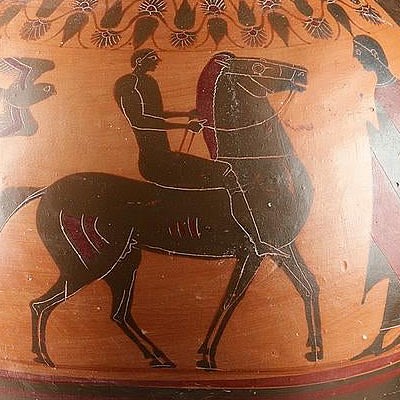Published / Huge Gandharan Stucco Buddha Head
Lot 106b
About Seller
Artemis Gallery
686 S Taylor Ave, Ste 106
Louisville, CO 80027
United States
Selling antiquities, ancient and ethnographic art online since 1993, Artemis Gallery specializes in Classical Antiquities (Egyptian, Greek, Roman, Near Eastern), Asian, Pre-Columbian, African / Tribal / Oceanographic art. Our extensive inventory includes pottery, stone, metal, wood, glass and textil...Read more
Categories
Estimate:
$20,000 - $30,000
Absentee vs Live bid
Two ways to bid:
- Leave a max absentee bid and the platform will bid on your behalf up to your maximum bid during the live auction.
- Bid live during the auction and your bids will be submitted real-time to the auctioneer.
Bid Increments
| Price | Bid Increment |
|---|---|
| $0 | $25 |
| $300 | $50 |
| $1,000 | $100 |
| $2,000 | $250 |
| $5,000 | $500 |
| $10,000 | $1,000 |
| $20,000 | $2,500 |
| $50,000 | $5,000 |
| $100,000 | $10,000 |
| $200,000 | $20,000 |
About Auction
By Artemis Gallery
Jun 4, 2020
Set Reminder
2020-06-04 10:00:00
2020-06-04 10:00:00
America/New_York
Bidsquare
Bidsquare : Exceptional Antiquities, Asian, Ethnographic
https://www.bidsquare.com/auctions/artemis-gallery/exceptional-antiquities-asian-ethnographic-5185
An important one-day auction featuring museum-worthy examples of Egyptian, Greek, Roman, Etruscan, Near Eastern, Far East / Asian, Pre-Columbian, African / Tribal, Oceanic, Native American, Spanish Colonial, Russian, Fossils, Ancient Jewelry, Fine Art, so much more! Artemis Gallery info@artemisgallery.com
An important one-day auction featuring museum-worthy examples of Egyptian, Greek, Roman, Etruscan, Near Eastern, Far East / Asian, Pre-Columbian, African / Tribal, Oceanic, Native American, Spanish Colonial, Russian, Fossils, Ancient Jewelry, Fine Art, so much more! Artemis Gallery info@artemisgallery.com
- Lot Description
Central Asia, Pakistan and Afghanistan, Gandharan Empire, ca. 4th to mid 5th century CE. A massive, larger-than-life stucco head of the enlightened Buddha, modeled in the traditional Greco-Buddhist tradition with a full face, fine, heavy-lidded downcast almond eyes, a naturalistic nose, and sensitive mouth. Interestingly, this example also has a strong browline and distinctive chin, with the chin in particular giving it a very lifelike appearance. The ears are long, their lobes stretched, signifying the former wealth of Prince Siddhartha. A deep, round uma is in the center of the forehead, which was likely once inlaid with a precious stone. Some traces of pigment remain on the face, notably on the browline and on the cheeks. Perhaps the most incredible part of this sculpture is its ornate hair and huge ushnisha. The hair is composed of layer upon layer of half-circles of stucco, giving it the appearance of tight curls, and these continue over the ushnisha, the visible sign of Buddha's enlightenment. Size: 12.25" L x 12" W x 19" H (31.1 cm x 30.5 cm x 48.3 cm); 25" H (63.5 cm) on included custom stand.
Alexander the Great conquered Gandhara in 330 BCE and with the help of Indo-Greek kings introduced classical traditions that would influence Gandharan art for the following seven centuries. The stylized curly Mediterranean hair and top knot derive from classical sculptures such as the Apollo Belvedere (330 BCE), but the Gandharans took that influence and made a complete style of their own, often focused on portrayals of the Buddha, as is so beautifully exemplified here.
Gandharans are famous for schist and stucco carvings, with stucco replacing schist as the dominant material around the 3rd century CE. Vast monastic institutions like those at Takht-i-Bahi, Sahri-Bahlol, Jamal Garhi, Ranigat, and Thareli were decorated by skilled artisans with stucco representations of important figures, religious scenes, and artistic dedications. Stucco allowed artists more freedom in portraying lifelike features, as shown in the shape of the chin here. During this time, Gandhara was exceptionally wealthy, profiting from trade along the Silk Road; patrons had resources to spend on the arts, creating a flowering of stucco artwork. Some monumental statues had stucco hands, feet, and heads alongside clay torsos - the size of these figures was such that clay was needed to maintain their form. See, for example, this image of a similar head atop a shrine in Afghanistan (photo taken in the 1980s, the shrine has since been destroyed): https://bit.ly/2TzK3kG.
Published in "The Muse's Song: Selections of Ancient Art." Fortuna Fine Arts, Ltd., New York, 2008, fig. 55.
Provenance: private East Coast, USA collection; ex-Alexandre A du M collection, Maryland, USA, acquired in the 1980s
All items legal to buy/sell under U.S. Statute covering cultural patrimony Code 2600, CHAPTER 14, and are guaranteed to be as described or your money back.
A Certificate of Authenticity will accompany all winning bids.
We ship worldwide and handle all shipping in-house for your convenience.
#142458Small losses on surface, notably on the side of the ushnisha and one earlobe. Back of the head is partially lost as is part of the neck, and these areas are fragile and may lose some material if not handled with care. Traces of pigment on face with nice deposits. Face and front of hair are beautifully preserved.Condition
- Shipping Info
-
All shipping is handled in-house for your convenience. Your invoice from Artemis Gallery will include shipping calculation instructions. If in doubt, please inquire BEFORE bidding for estimated shipping costs for individual items.
-
- Buyer's Premium



 EUR
EUR CAD
CAD AUD
AUD GBP
GBP MXN
MXN HKD
HKD CNY
CNY MYR
MYR SEK
SEK SGD
SGD CHF
CHF THB
THB















